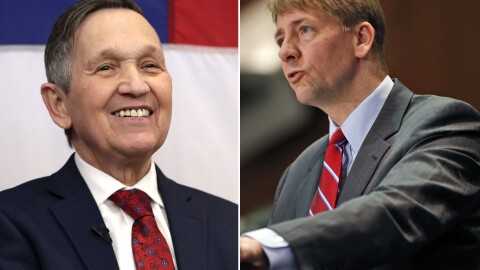Boxes of campaign literature clutter the floors and signs cover the walls of Cordray’s Columbus office. All of this, and a sign inviting volunteers to enjoy campaign snacks, serves as a testament to long hours spent on outreach efforts there.
But Cordray, the former Ohio Attorney General and head of the Consumer Financial Protection Bureau, finds himself spending most of his time on the road these days.
“We are fighting for every vote at this point,” Cordray says. “Primaries are difficult events. And we have been all over the state and will continue to be all over the state, making sure people get our message, making sure we get our vote out, and we will be working right up through Tuesday.”
It’s crunch time for Ohio’s Democratic gubernatorial candidates, who are making their final pitches to voters as the May 8 election draws closer.
Cordray, who is thought to be the frontrunner, has support from President Barack Obama, Massachusetts Sen. Elizabeth Warren and many key Democratic leaders and unions. But he finds his race is a little tougher than some may have anticipated a few months ago.
Former Cleveland mayor and Rep. Dennis Kucinich won some major endorsements from progressive groups that backed Bernie Sanders in the 2016 presidential primary, as well as the endorsement of the Cleveland Plain Dealer. What Kucinich and the other candidates in the race don’t have is Cordray’s money.
Cordray has $1.6 million in the bank, while the others have less than a million. But Kucinich says he has enough to run some radio ads, and he’s got dedicated volunteers.
“This is really a mass movement that’s gathering momentum that has actually much more value,” Kucinich says. “You know each person, to me, is worth a considerable amount of money. Having a volunteer in a campaign will sometimes outweigh a contribution of four figures.”
State Sen. Joe Schiavoni says he’s focused his money on ads for social media where a lot of voters, particularly younger ones, spend their time. He says his campaign will be knocking on doors, making phone calls and talking to voters throughout Ohio.
“It’s a true, grassroots effort,” Schiavoni says. “And you know, Rich Cordray is going to be on TV and I’m not, but it doesn’t mean that we can’t win. And underdogs win when they are overlooked.”
Former Ohio Supreme Court Justice Bill O’Neill is also thought to be an underdog in this race. But he says he’s feeling good going into the last days of the race. He says there’s momentum behind his campaign.
“We’re kind of getting overwhelmed by responses on the internet and on the phone,” O’Neill says. “We found ourselves late last week having to order another 100,000 pieces of campaign literature. We just bought more radio time because people are contributing and people are getting excited about this race because it has clearly come down to a four-way race. I don’t think anybody would challenge that.”
Though it appears most establishment Democrats are behind Cordray, Ohio Democratic Party Chair David Pepper says the organization has not endorsed a Democratic gubernatorial candidate. Rather, they’re using the statewide redistricting proposal, Issue 1, to get voters to polls.
“Our big push is to make sure voters are coming out in the primary because Issue 1 is on the ballot and we really want it to pass and we know Democratic voters are very supportive of it,” Pepper says.
Early vote totals from the Secretary of State’s office show more than 220,000 ballots have been requested as of Friday. Of those, 115,000 have been Democratic ballots, compared to 91,000 Republican ballots. The return rate for both is around 58 percent.
The average voter turnout for a gubernatorial primary in Ohio is around 29 percent, but there’s no projected turnout set yet for this Election Day.






